Astronomy Technologies Astro-Tech AT6RC Quick start guide
- Category
- Telescopes
- Type
- Quick start guide

Thank you for choosing this Astro-Tech AT6RC
Ritchey-Chrétien reflector, selected as a
Sky & Telescope
Hot Product
for 2009.
Your AT6RC is designed primarily as an astrograph for
exceptional coma-free imaging using webcams, Deep Sky
Imager-type cameras, and DSLRs.
Visual observing is also possible with your AT6RC,
however. The scope’s 2” Crayford focuser will accept both
1.25” and 2” star diagonals.
This instruction sheet will provide you with information
on how to get the most out of your new Ritchey-Chrétien
reflector, and how to properly maintain your telescope
so it can give you a lifetime of observing and imaging
enjoyment.
Please familiarize yourself with your scope’s parts and
functions before operating it for the first time.
astro-tech
AT 6 R C
from Astronomy Technologies
Lock knob for focuser drawtube; a
drawtube tension knob is hidden
behind the coarse focus knob
Vixen-style equatorial
mount dovetail
PARTS OF THE AT6RC
1.25” accessory
lock knob
Right coarse
focus knob
1.25” accessory
adapter
Fine
focus
knob
Mounting shoe for optional finder
Locking collar for 360° rotatable focuser
Left coarse
focus knob
Fine
focus
knob
Focusing
scales on
focuser
drawtube
2” accessory
lock knob
Right
coarse
focus
knob
Dust cap
Optional thread-on
extension rings
Aperture .................................................... 152mm (6”)
Focal Length .................................................. 1370mm
Focal Ratio ............................................................... f/9
Optical Type .............................. dual hyperbolic mirror
true Ritchey-Chrétien reflector
Mirrors .......................... BK7 optical glass, coated with
enhanced aluminum and overcoated with quartz
Secondary Mirror Holder Obstruction ............. 76mm
(50% by diameter, 25% by area)
Field Stops ................. eight internal knife-edge baffles
Focuser Travel .......... 1.34” (34mm) with dual inch and
millimeter scales on drawtube for repeatable focus
Astro-Tech AT6RC Ritchey-Chrétien Reflector Specifications
Focuser ....................... thread-on dual-speed Crayford
with 10:1 reduction ratio fine focus;
2” and 1.25” compression ring accessory holders;
360° rotating camera angle adjuster
Back Focus ...................................................... 150mm
(from 2” accessory holder, without 1.25” adapter)
Tube Diameter................................. 7.5” (190mm) o. d.
Tube Length ......................................... 19.6” (498mm)
Tube Weight ...................................... 12.1 lbs. (5.5 kg)
Mounting System ..... 12.75” long Vixen-style dovetail;
Finder ........ none; mounting shoe provided for optional
Astro-Tech multiple reticle finder or similar finder
Your Astro-Tech AT6RC 6” f/9 true Ritchey-Chrétien reflector is
designed primarily for exceptional astronomical imaging. It provides
you with the coma-free photographic field astrophotographers crave,
but can’t get, from conventional reflectors and Schmidt-Cassegrains.
Visual observing is also possible, although with somewhat reduced
contrast compared to conventional reflectors. There is a 2” compres-
sion ring accessory holder on the focuser drawtube, plus a separate
1.25” compression ring accessory holder, so you can use either 1.25”
or 2” star diagonals and eyepieces.
Back Focus and the Focusing System: The back focus of the
AT6RC is 150mm from the face of the focuser’s 2” accessory holder.
Adding the 1.25” adapter reduces the back focus by 10mm. When
using the AT6RC visually, you may have to add an optional Astro-Tech
2” compression ring extension tube (available in 35mm, 50mm, and
80mm lengths) between the focuser and 1.25” star diagonal, or in
your 2” diagonal eyepiece holder, to reach focus with your eyepieces.
To minimize drawtube flexure under heavy loads during imaging,
the drawtube travel of the thread-on focuser is kept short, at 34mm.
Depending on your camera and imaging accessories, you will have to
add one or more optional thread-on metal extension rings between
the focuser and the AT6RC rear cell to move the focuser out from the
scope body to hold your camera at the telescope focal plane. These

optional Astro-Tech 3.7” diameter extension rings (available in both
1” and 2” lengths) thread in place securely to provide a very strong
and rigid mount that holds the focuser at the proper spacing from the
scope body to suit your particular camera’s requirements.
Two 2” #AT2EXT extensions or a combination of one 2” and one or
two 1” #AT1EXT extensions will generally be needed for imaging
with webcams and DSLRs. Knowing the distance from the front of
your camera adapter to the camera’s focal plane and a little calculation
beforehand will quickly determine what combination of optional
extension rings will be needed for your particular imaging setup.
Be careful not to cross-thread any of the focuser extension
rings when and if changing them in the dark.
The Crayford Focuser: The backlash-free focuser has dual-speed
focusing. There are two coarse focusing knobs. The right knob also
has a smaller concentric knob with a 10:1 reduction gear for microfine
focusing. This provides very precise image control during high power
visual observing and critical DSLR imaging. The focus knobs have
ribbed gripping surfaces so they are easy to adjust, even while wear-
ing gloves or mittens in cold weather.
There are two chrome lock knobs on the underside of the focuser,
as shown in the illustration below. The rear knob (closest to the ob-
server) adjusts the tension on the Crayford focuser to accommodate
different weight equipment loads without focuser slippage.
The rear
tension knob should always be tightened firmly, even with a
light equipment load, to avoid drawtube flexure.
The front knob (closest to the scope) locks the focuser drawtube
firmly in place (disengaging the focusing knobs) once the correct
photographic focus has been reached.
Rotating the Focuser: The AT6RC focuser can be rotated a full
360° for the best photographic composition prior to critical focusing,
or to put your star diagonal in the most comfortable visual observing
position. To rotate the focuser, loosen the ribbed locking collar con-
necting the focuser to the telescope rear cell or extension ring by
turning the collar slightly counterclockwise. Adjust the focuser to the
desired angle, and then firmly tighten the collar back in the opposite
direction to lock the focuser at the new angle.
astro -tech
www.astronomytechnologies.com
from Astronomy Technologies, 680 24th Avenue SW, Norman, OK 73069
© 2010 by Astronomy Technologies Specifications, features, and descriptions are effective 7/1/2010, but are subject to correction and/or modification without notice and/or obligation.
Optional
extension
rings
Crayford
focuser
Optical
tube
THE PARTS
OF THE AT6RC
FOCUSING
SYSTEM
Rear
cell
Front lock knob:
locks drawtube in place
Rear lock knob:
adjusts drawtube tension
AT6RC FOCUSER LOCK KNOBS
Mounting Your AT6RC: The underside of the AT6RC has a 12.75”
long Vixen-style dovetail bar running from front cell to rear cell. This
will let you mount your AT6RC on any equatorial mount using a Vixen-
style dovetail. You can also piggyback it on a larger scope using any
accessory mounting system (such as those from Losmandy) that has
a Vixen-style dovetail. The long length of the dovetail bar makes it
easier to balance the AT6RC and varying equipment loads. An op-
tional Vixen-style dovetail #AT6SDP is available for installation on top
of the AT6RC. This lets you install a photoguide scope on top of the
optical tube when using the AT6RC as your primary scope.
Finderscope: No finderscope is provided, due to the primarily
photographic nature of the AT6RC. However, a mounting shoe is pro-
vided on the rear cell that will hold an optional Astro-Tech #ATF non-
magnifying illuminated multireticle finder, or any similar finder or
photoguide ring system that uses a Vixen-style mounting shoe.
Caring for Your Scope Finish: The AT6RC uses automotive-
grade paints and anodized components. These very durable surfaces
can become smudged with fingerprints during use, but these will not
harm the finish. A little moisture from your breath and a quick wipe
with a clean handkerchief is generally enough to remove the finger-
prints. Avoid harsh chemical cleaners or organic solvents like ben-
zene, alcohol, etc., as these may ruin the finish.
Cleaning Your Scope Optics: Because of the positioning of the
mirrors within the optical tube, they will rarely (if ever) need clean-
ing. Small amounts of dust will not appear in the image or block
enough light to be an issue and can be safely ignored. If you abso-
lutely feel you
must
clean the optics, however, it can be done at your
own risk. You will have to disassemble the optical tube to do it, so it
is not something that should be undertaken lightly.
Referring to the illustration above, with the nose of the scope rest-
ing on a flat surface, start by undoing the four screws that hold the
dovetail to the optical tube. Remove the dovetail. Set the four screws
aside so you don’t mix them up with the other rear cell hardware.
Use two small pieces of masking tape to mark the position of the
rear cell in relation to one of the optical tube screw holes so you can
reassemble the rear cell and tube in its original radial orientation.
Remove the remaining four rear cell screws to release the rear cell
and lift it straight up and out of the optical tube.
Any damage to the AT6RC sustained during an attempt to
disassemble and clean the optics is not covered by warranty.
Collimating Your AT6RC Optics: Your Astro-Tech AT6RC Ritchey-
Chrétien’s primary and secondary mirrors were collimated at the fac-
tory before being shipped. Nevertheless, rough treatment in transit
could potentially cause the secondary mirror to be knocked out of
collimation, and rough and bumpy roads during trips to a dark sky
observing site might require minor tweaking of the collimation. The
optical axis of the primary mirror/baffle tube assembly is less likely to
be knocked out of collimation, but is also capable of being collimated
if needed. If collimation of your AT6RC is needed, refer to the sepa-
rate “Collimating an Astro-Tech AT6RC” instruction sheet.
Mirror collimation
screws: six total in
three pairs (see
separate collimation
sheet)
Dovetail/rear cell
screws (one pair)
Rear cell screws (six total: two
on top; two on bottom through
the dovetail and holding it in
place; plus one on each side)
Front
dovetail
screws
(one pair)
Rear cell
SCREWS HOLDING REAR CELL TO OPTICAL TUBE
Optical
tube
Ribbed locking collar:
locks focuser rotation and
allows focuser removal
-
 1
1
-
 2
2
Astronomy Technologies Astro-Tech AT6RC Quick start guide
- Category
- Telescopes
- Type
- Quick start guide
Ask a question and I''ll find the answer in the document
Finding information in a document is now easier with AI
Related papers
-
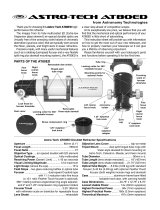 Astronomy Technologies Astro-Tech AT80ED User manual
Astronomy Technologies Astro-Tech AT80ED User manual
-
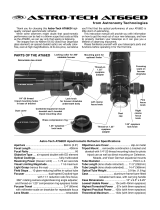 Astronomy Technologies AT66ED User manual
Astronomy Technologies AT66ED User manual
-
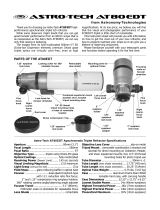 Astronomy Technologies AT80EDT User manual
Astronomy Technologies AT80EDT User manual
-
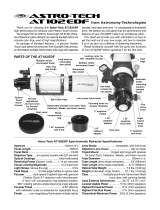 Astronomy Technologies AT102EDF User manual
Astronomy Technologies AT102EDF User manual
-
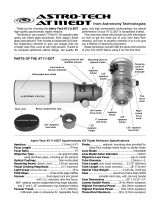 Astronomy Technologies AT111EDT User manual
Astronomy Technologies AT111EDT User manual
-
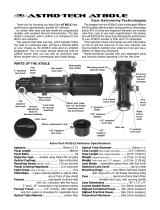 Astronomy Technologies Astro-Tech AT80LE User manual
Astronomy Technologies Astro-Tech AT80LE User manual
-
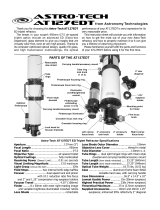 Astronomy Technologies AT 127EDT User manual
Astronomy Technologies AT 127EDT User manual
-
 Astronomy Technologies Astro-Tech AT90EDT User manual
Astronomy Technologies Astro-Tech AT90EDT User manual
Other documents
-
Orion F/3.9 User manual
-
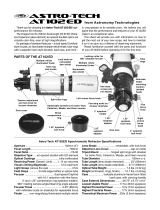 Astro-Tech AT102ED User manual
Astro-Tech AT102ED User manual
-
Explore Scientific 0112086 Owner's manual
-
Orion 9791 User manual
-
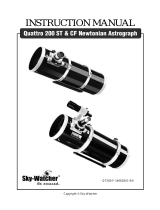 Sky-Watcher Quattro 200 Newtonian User manual
Sky-Watcher Quattro 200 Newtonian User manual
-
Orion 8297 Newtonian Astrographs Reflector Telescope User manual
-
Orion 8296 User manual
-
Orion XT10 User manual
-
Meade 37-0850-00 Owner's manual
-
Orion 10020 XT12i User manual











